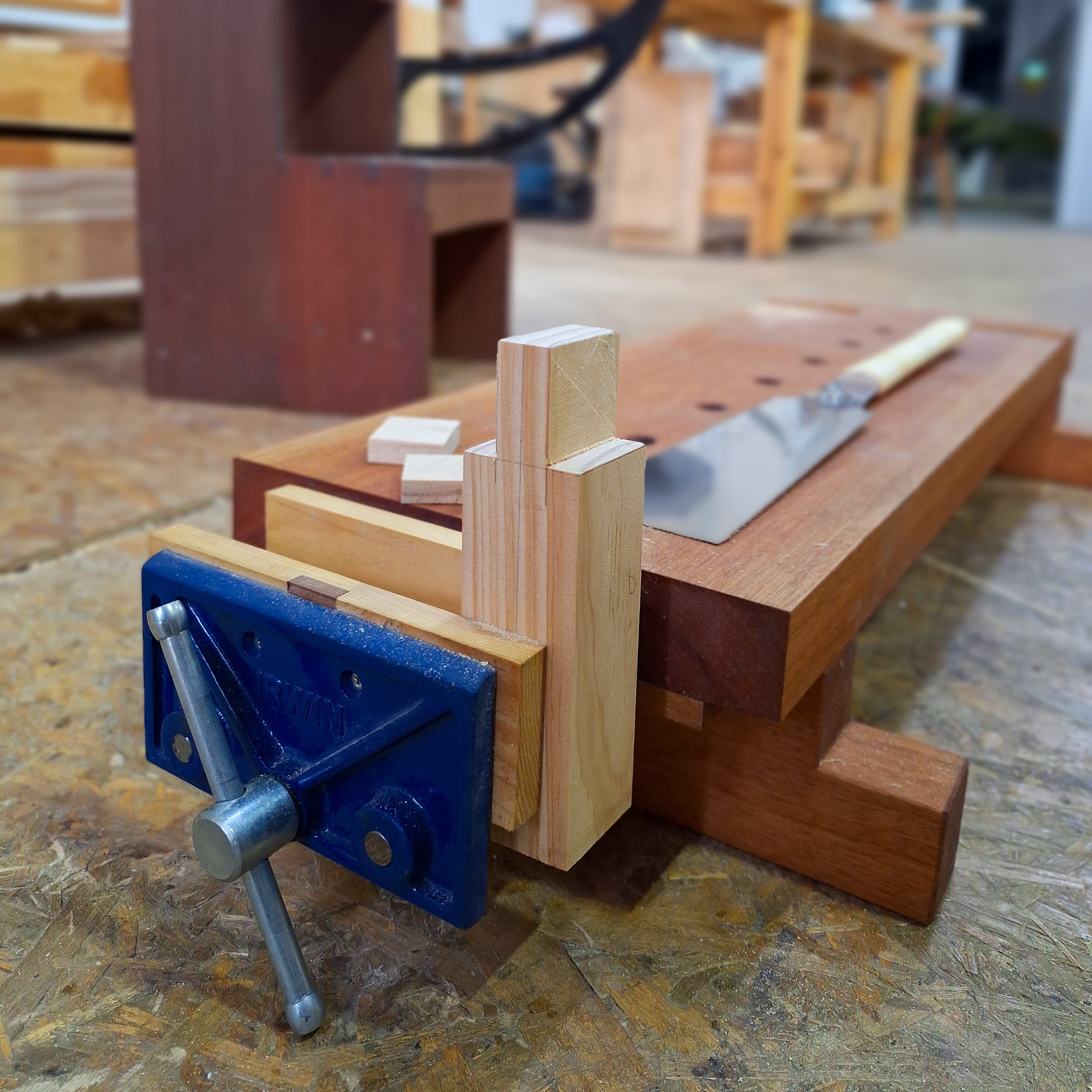Learn Advanced Japanese Woodworking.
The Shokunin Advance Course continues from the Shokunin Intermediate Course. Through the construction of a pair of sawhorses, students learn to cut two fundamental joints: the mortise and tenon joint, and bridle joint. These are right angle joints that connect two pieces of timber at 90 degrees.
The mortise and tenon is one of the major and widely used joints in carpentry across the world. It can be found in the frames of traditionally constructed houses, chairs, tables and cabinets. By learning its most basic form, students will be equipped to craft its numerous variations and also expand the range of projects they can build.
Sawhorses are often one of the first few things carpenters build, along with their toolbox and workbench. Designed for utility, they facilitate sawing and provide a stable work surface off the ground, both for indoor and outdoor site use.
Approximate dimensions of one sawhorse: L400 x W300 x H200
Find out more about the Shokunin Series here.
Is this course for me?
As this is an advanced course, there are prerequisite skills required. If you have taken the Shokunin Intermediate Course, then this is a natural progression for you. For advanced hobbyists / craftsmen / tradesmen, you’ll need to own and know how to use a saw and chisel. You’ll be required to bring along your own chisels and sharpening stone/s for use during the course.
What you will learn:
Acquire essential competencies of precision sharpening tools. A sharp tool is not only safer to use, it gives the craftsman the ability to craft precisely fitted joints that the Japanese are known for.
How to set up a Japanese bench chisel (oire-nomi) and paring chisel (tsukki-nomi) for use. You will receive as part of the course two new professional grade Japanese chisels and learn how to get it ready for use.
Learn about the mortise and tenon joint and bridle joint. Understand their structure, function and applications.
Learn to layout and cut joints on stock of larger dimensions. Handling larger stock requires slightly different techniques and approaches. One example is employing the centre line marking system used by Japanese carpenters. Learn how to mark accurately for joinery. A pencil line makes a big difference between an ill or great fitting joint!
Develop advance psycho-motor carpentry skills. You will develop the hand skills of using the saw and chisel for joinery. You will learn not only how to cut well-fitted joints by hand, but how to do so with speed and efficiency characteristic of the shokunin, all the while maintaining high levels of precision.
At the end of the course, you would have built a pair of utilitarian sawhorses that will serve you well in your future projects.






Workshop Details
Workshop Date: TBA
Class duration : 3 days, 9am - 6pm daily
Suitable for: Age 18 and above
Number of participants: Maximum class size of 4
Course Fees : $980 per participant. Includes two professional grade Japanese chisels - a bench chisel (oire-nomi) and paring chisel (tsukki-nomi) worth $250. Course fees are non-refundable. This course is not Skillsfuture enabled.
Students will be required to bring their personal sharpening stone, kanna and sashigane/ square. Free storage is available for the duration of the workshop.
Registration Fee: One-time Mokko Wood Studio registration fee $50. Registration fees are waived for participants who have taken prior courses at Mokko Wood Studio.
What you will be doing for the 3 days.
In this course, you will add two new tools to your toolkit: the bench chisel (oire-nomi) and paring chisel (tsukki-nomi). You will then be guided through the process of building a pair of sawhorses.
The first day of the course begins with setting up the new chisels for use and sharpening them to a fine, crisp edge for cutting precise joinery. You will then learn about the joints to be used and how to employ a different system of layout from what was taught in the Intermediate Course.
The next days of the course will commence with joinery work. Students will learn to cut joints by hand in the traditional way. In addition, they will be exposed to alternative methods.
Proper techniques of sawing and chiselling will be emphasized - because it is not merely the sawhorses that you will take home, more importantly, it is to take home the skills that you will gain to continue building items long after the workshop is over.
Day 1
Introduction to the Japanese paring chisel (tsukki-nomi)
How to prepare and tune the tsukki-nomi for use
Principles of Sharpening woodworking blades
Understanding the mortise and tenon joint and bridle joint
Low Sawhorses Project: Layout
Day 2
Sawing and Chisel techniques
Low Sawhorses Project: Cutting the first mortise and tenon
Low Sawhorses Project: Joinery practice
Day 3
Low Sawhorses Project: Cutting the first bridle joints
Low Sawhorses Project: Pinning the joints
Low Sawhorses Project: Assembly of first sawhorse
Low Sawhorses Project: Building the second sawhorse
Registration
You will be directed to a registration page to fill in some basic details. We will then be contacting you with payment instructions within 3 days of receiving your registration. Your registration is only confirmed with payment. Accepted forms of payment are bank transfer, PayNow, Paylah!, and PayPal.
Questions?
Please contact us for any queries.
If you’re travelling from abroad, you may find our Support for International Students page helpful with your planning.

